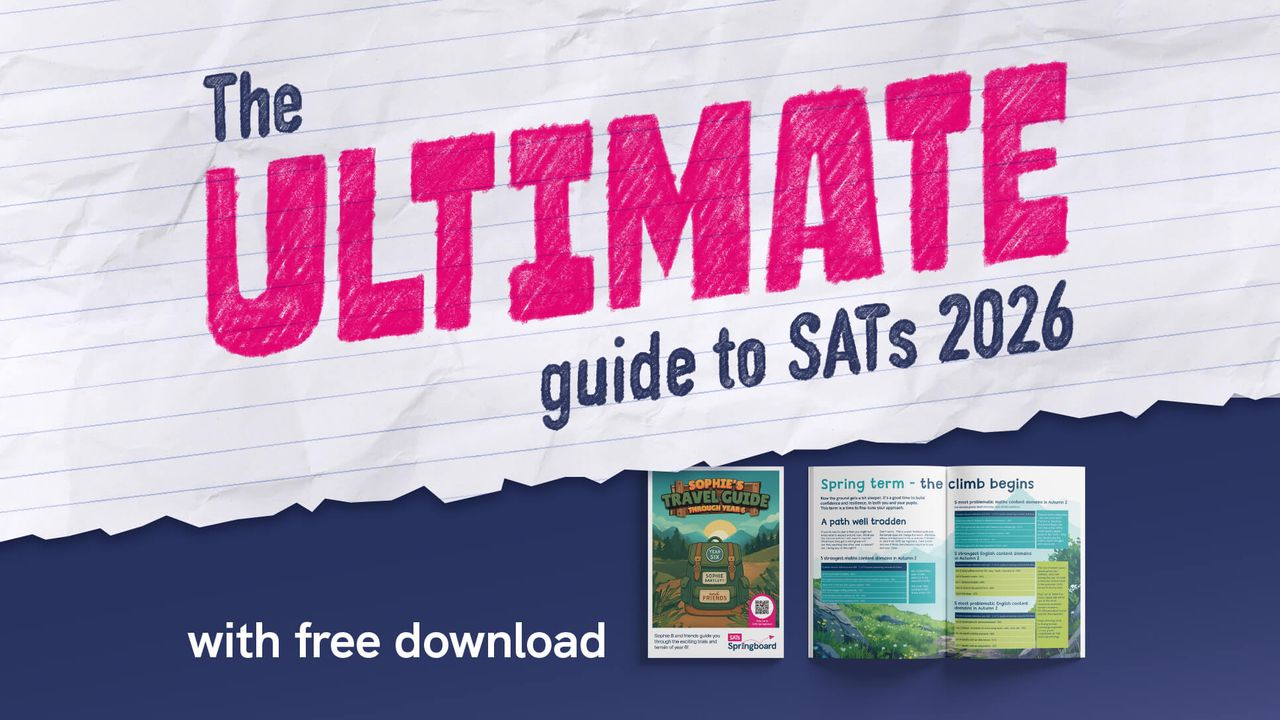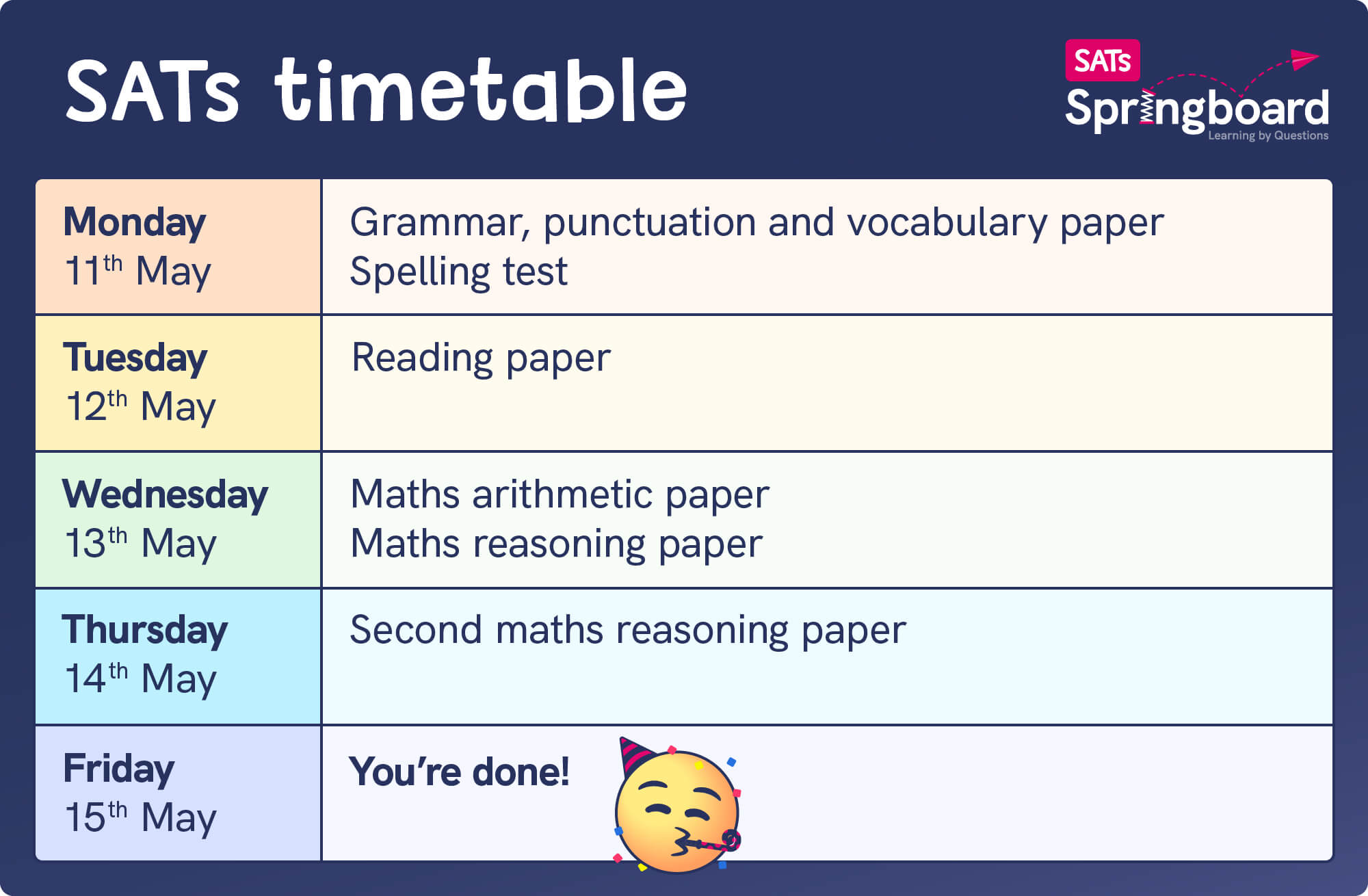The ultimate guide to KS2 SATs: dates, papers, revision and results
Your complete guide to KS2 SATs. Find test dates, a breakdown of English and maths papers, revision strategies, access arrangements, and results information for teachers and parents.

This guide is updated annually. The information below is for the KS2 SATs taking place in May 2026.
Preparing for the KS2 SATs? This ultimate guide provides everything you need to know. We provide the exact 2026 SATs dates, and give a breakdown of each test paper, including the reading, GPS (SPaG) and maths papers. You’ll also find information on access arrangements, results and effective revision strategies. Whether you’re a teacher, leader or even a parent, this is your one-stop resource for the KS2 SATs.
When are the KS2 SATs 2026?
SATs 2026 take place from Monday 11th May 2026 to Thursday 14th May 2026. Pupils in Y6 will sit both the English Grammar, Punctuation and Spelling papers on Monday 11th May, the English Reading paper on Tuesday 12th May, Maths papers 1 (arithmetic) and 2 (reasoning) on Wednesday 13th May and Maths paper 3 (reasoning) on Thursday 14th May.

What are KS2 SATs?
The KS2 SATs are national curriculum tests for year 6 pupils in England that assess their knowledge in English (reading, grammar, punctuation, and spelling) and maths. All year 6 pupils (10-11 year olds) in England sit the SATs, and they take place each May, usually in the second week.
Teacher looking for more in depth help? Sophie Bartlett's Travel Guide Through Year 6 will have you sorted.
What's in the KS2 SATs? English and Maths Papers Explained
In year 6, pupils sit national tests in English (Reading and Grammar, Punctuation and Spelling) and Maths (Arithmetic and Reasoning).
KS2 SATs GPS or SPAG Paper 2026: Format, marks and timing
Taken on the Monday 11th May 2026, Year 6 pupils will sit two papers for GPS.
Paper 1: questions mainly focused on grammar and punctuation, but spelling is still taken into account. The test lasts for 45 minutes and is worth a total of 50 marks.
Paper 2: an aural spelling test. Spellings are read out by the teacher and pupils note them down. Each spelling is worth 1 mark and there are 20 spellings.
What's in the Year 6 SATs Reading Test?
Year 6 children have one hour to sit the reading paper, where they are assessed on their responses to three texts.
It’s worth a total of 50 marks.
It will always have at least one non-fiction text, and at least one fiction text.
The third text is usually the toughest in terms of lexile range and the trickiest questions.
Pupils will answer a set of questions about each text. The questions will test them on their skills and knowledge in: retrieval, inference, vocabulary, summarising, author choice, prediction, comparison and contrasting.
KS2 SATs Maths Test: Structure, Marks and Timings
There are three parts to the maths test, testing children on content from across KS2:
Paper 1: arithmetic (30 minutes, 40 marks, usually sat on the Wednesday of SATs week)
Paper 2: reasoning (40 minutes, 35 marks, usually also sat on the Wednesday)
Paper 3: reasoning (40 minutes, 35 marks, usually sat on Thursday - the last test of the week!)
This means that there are 110 marks available in total to be gained from all of the maths SATs papers.
Did you know? Over Half of KS2 Maths SATs Content is from Years 3-5
Between 52 and 63% of content on past maths papers have been from years 3, 4 and 5 content domains.

How is science assessed?
Science is teacher-assessed at KS2, using evidence gathered throughout the year rather than a formal written test.
What’s the purpose of the SATs?
SATs are designed to find out if children are on track to meet the expected standards in English and maths, as set out by the government’s national curriculum. The tests serve as a litmus test to ensure that teachers and schools are doing everything they can to ensure the best possible pupil progress. Because SATs measure school performance (as opposed to grading the individual child) the assessments take into account teaching and learning across the entirety of Key Stage 2, not just that of year 6.
Who takes the KS2 SATs?
Year 6 pupils (10-11 year olds) in England take the KS2 SATs at the end of KS2. While schools have to have the assessments, headteachers can decide whether it’s appropriate for some pupils to do them. Some pupils, for example those with special education needs or disabilities, may therefore be assessed under different arrangements.
SATs revision and intervention strategy for 2026
According to data from Learning by Questions* 49% of teachers start revision for SATs in Autumn 1, 17% in Autumn 2 and a further 10% start in January. No matter when or how you prepare for SATs, the following should give you a helping hand.

Information for parents on SATs
At a basic level, parents should be informed of when the SATs are and how they might support their child both academically and emotionally. After the tests, parents must also be informed of results by the end of the academic year.
Beyond that, Learning by Questions has put a full guide together aimed at both parents and children, providing them with key information, tips and resources for revision at home.
Get Spill the Beans on SATs, a guide for parents and pupils
Intervention and revision strategy
SATs test pupils’ understanding of learning objectives from year 3 to year 6, therefore the most effective strategies address previous learning gaps by finding and filling gaps in knowledge and skills quickly, effectively and with low/no stress.
The best intervention and revision strategies start with identifying as well as addressing specific learning gaps. At Learning by Questions, we’re in a unique position to be able to gather numerical evidence of where the most common gaps are for year 6 across the nation.
Key fact: in Autumn 1, 72% of Y6 Springboard users couldn’t identify the number of edges on a cube
And, in Autumn 1 of 2025, only 22% were able to correctly place a possessive apostrophe.
Want more? Gaps in knowledge and skills across the nation and resources to plug them
SATs Springboard from Learning by Questions has SATs diagnostic resources in maths, reading and GPS, meaning you can spot learning gaps early and provide individualised resources that address those gaps head on. We offer a free trial of SATs Springboard, meaning you can start finding and solving issues straightaway.
What to send home for SATs revision?
Daily reading, mental maths, practice papers all make great revision activities throughout the year. For most pupils, these can be carried out no matter what the situation at home. If you trial SATs Springboard, activities can be set to plug individualised gaps in learning, plus feedback after every answer means children are supported every step of the way.
Some lesser known activities might be ones centered around mental health. Encouraging children to partake in mindfulness at home could help to build resilience for test week. The Thrive Approach has free resources available to enhance emotional wellbeing.
Information on KS2 SATs access arrangements
Access arrangements might be needed for pupils with additional needs or those who speak English as an additional language to make sure they have a fair chance at succeeding.
Our full and easy to understand guide to access arrangements covers all the frequently asked questions and is based on the government's guidance.
Administering the tests
The government provides guidance on administering the KS2 SATs. Guidance for the 2026 KS2 SATs will be updated in March 2026. The 2025 government guidance might still help with some of the organisation of admin, but be aware the dates are for the 2025 tests.
When will the 2026 papers be available?
The Standards and Testing Agency generally releases SATs papers two weeks after SATs week, which for 2026 would be around the 29th May. Please be aware, this is not set in stone and could change. The delay in releasing papers is to ensure any pupils absent during SATs week have a fair opportunity to sit the papers.
When will Sophie B’s analysis of the 2026 SATs papers come out?
As soon as the papers are released — plus a little extra to get the analysis written and published.
When are the KS2 SATs results released?
For SATs 2026, schools can view results online from Tuesday, July 7, 2026. Schools decide how they give out test results and teacher assessment judgements to children and parents, but these should be received by the end of summer term 2026.
Helpful links to prepare for SATs
If you're looking for full guidance from the government, their advice for headteachers, teachers and test administrators for the key stage 2 SATs tests is the best place to go.
If you want a breakdown of the papers from 2025, you can read Sophie B’s 2025 analysis of the maths papers, Sophie B’s analysis of the 2025 reading paper or her analysis of the 2025 GPS paper.
If you want information on the results from 2025, Sophie strikes again with her 2025 KS2 SATs results analysis.
Finally, if you’d like to invest in tangible support with SATs this year, you can trial SATs Springboard from Learning by Questions. 100% of users asked said it significantly reduced their workload and 98% said their children made greater academic progress. Find out more about SATs Springboard.
*Data taken from 859 SATs Springboard users who have used a diagnostic resource since 2024.
